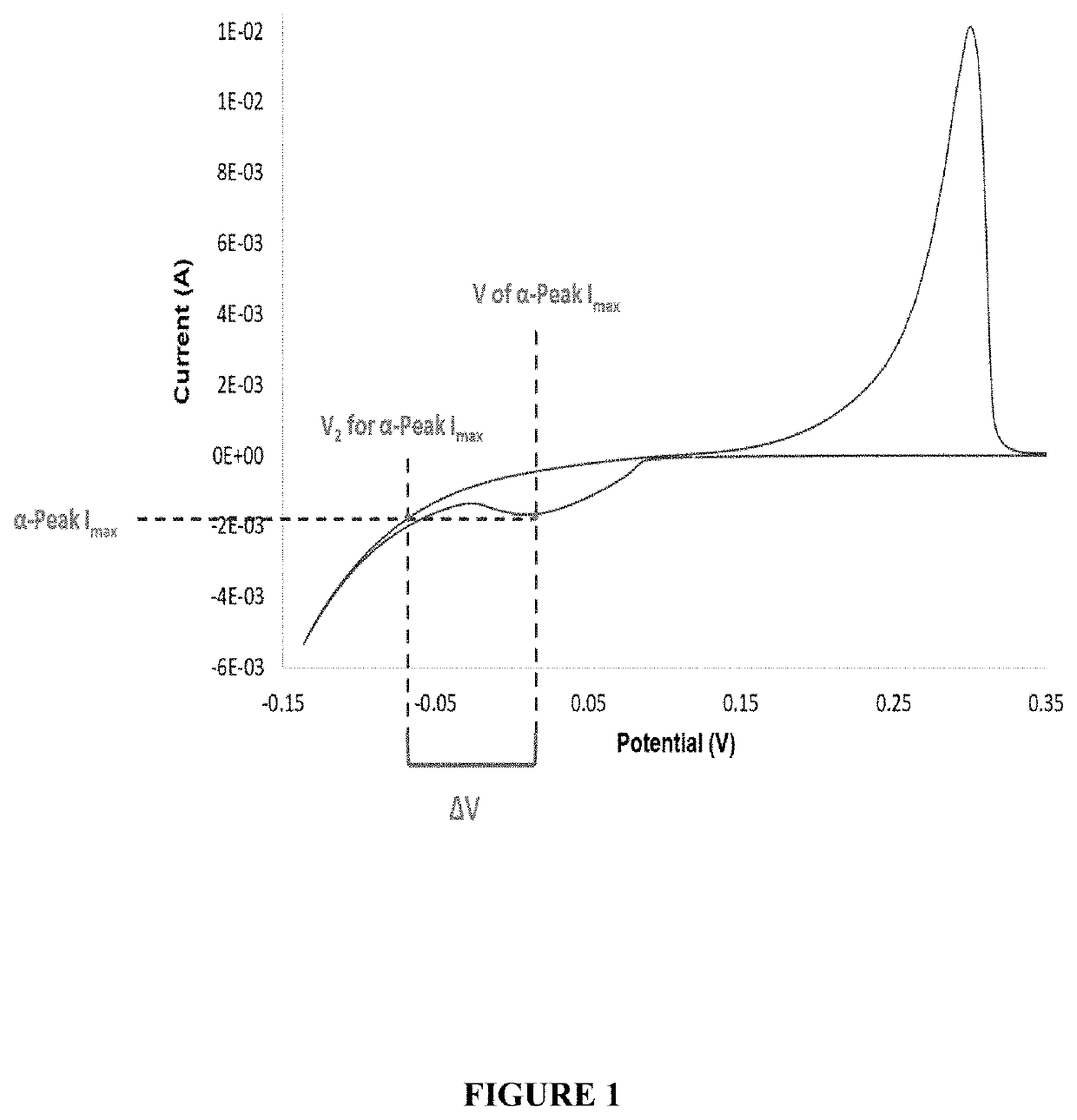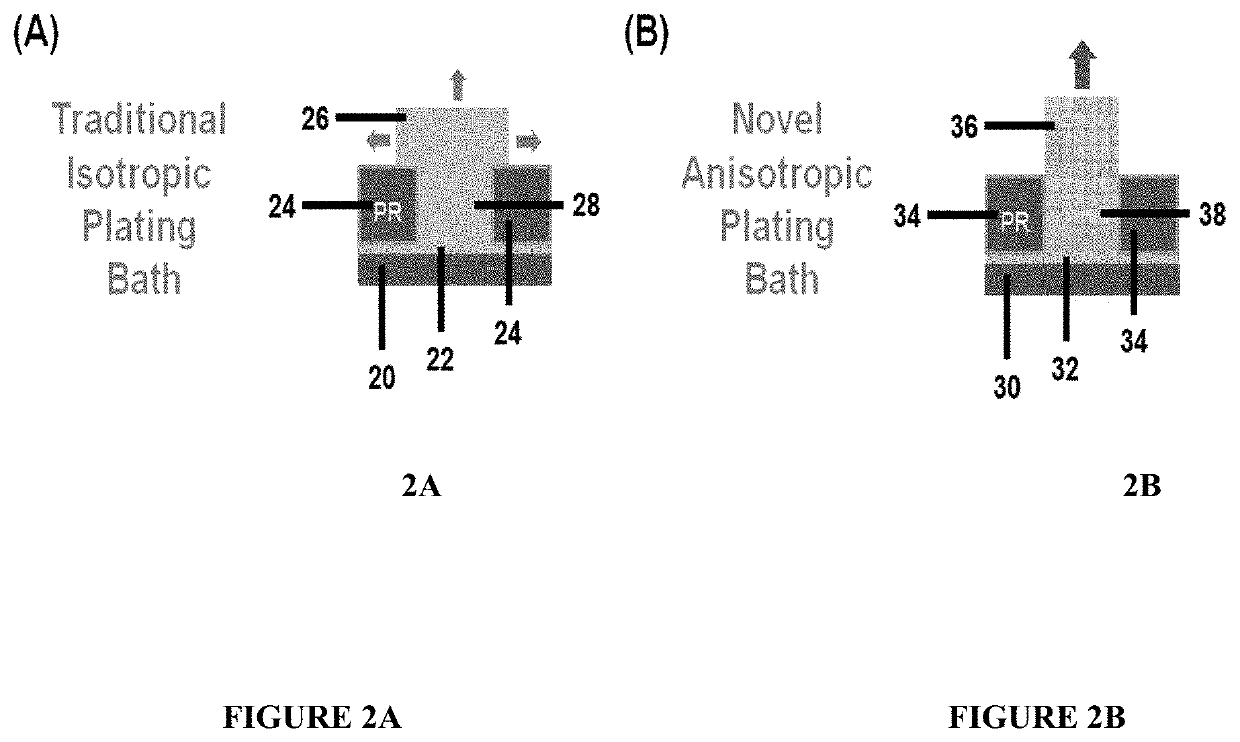Photoresist resolution capabilities by copper electroplating anisotropically
- Summary
- Abstract
- Description
- Claims
- Application Information
AI Technical Summary
Benefits of technology
Problems solved by technology
Method used
Image
Examples
examples 1-2
Plating Height Levelling on 3-mercapto-propylsulfonic Acid Sodium Salt Activated 1-100 μm Fine-line Pattern with Highly Anisotropic Bath 3, vs. No Activation with Isotropic Bath 1
[0056]The following two copper electroplating baths were prepared:
Plating Bath 1 (Isotropic Bath):
[0057]50 g / L Cu(II) ion[0058]100 g / L H2SO4 [0059]50 ppm Chloride ion[0060]5 ppm Bis-Sodium-Sulfopropyl-Disulfide[0061]2 g / L EO-PO random copolymer with average MW 1,100 and hydroxyl end groups 5 ppm reaction product of epichlorohydrin and imidazole
Plating Bath 2 (Anisotropic Bath):
[0062]50 g / L Cu(II) ion[0063]100 g / L H2SO4[0064]50 ppm Chloride ion[0065]40 ppm Bis-Sodium-Sulfopropyl-Disulfide[0066]2 g / L EO-PO random copolymer with average MW 1,100 and hydroxyl end groups[0067]1 ppm reaction product of butyldiglycidylether, imidazole and phenylimidazole
Plating Bath 3 (Anisotropic Bath):
[0068]50 g / L Cu(II) ion[0069]100 g / L H2SO4 [0070]50 ppm Chloride ion[0071]20 ppm Bis-Sodium-Sulfopropyl-Disulfide[0072]2 g / L Diam...
examples 3-6
Line Broadening on MES Activated 1-100 μm Fine-line Pattern with Highly Surface Reactive Bath 2, vs. No Activation with Non-surface Reactive Bath 1
[0075]A silicon wafer coated with a 20 nm Ti adhesion layer and a 200 nm conductive Cu seed was laminated with a PR layer with a thickness of 3 μm. A fine line pattern was built on the PR layer to contain a series of trenches ranging from 1 to 100 μm in width. These trenches were then plated to a target height of 4.5 μm using either Plating Bath 1 or Plating Bath 3. In each case, the samples were either wetted with DI water prior to plating, or they were first immersed in a pH 0.7 solution of 4 g / L MES in water and then rinsed with DI water prior to plating. In all cases, electroplating was carried out at 2 ASD with a cathode rotation rate of 50 rpm. Following plating, the PR was removed in a PR stripper bath to yield a pattern of fine lines. The sample was then exposed to a seed etch solution to remove the remaining conductive seed that ...
examples 7-10
Line Broadening on MES Activated 1-100 μm Fine-line Pattern with Highly Surface Reactive Bath 3, vs. No Activation with Non-surface Reactive Bath 1
[0076]A silicon wafer coated with a 20 nm Ti adhesion layer and a 200 nm conductive Cu seed was laminated with a PR layer with a thickness of 3 μm. A fine line pattern was built on the PR layer to contain a series of 100 μ-wide trenches. The substrate was then plated to a target height of 36 μm using either Plating Bath 1 or Plating Bath 3. The sample plated with Plating Bath 1 was wetted with DI water prior to plating. The sample plated with Plating Bath 3 was first immersed in a pH 0.7 solution of 4 g / L MES in water and then rinsed with DI water prior to plating. In both cases, electroplating was carried out at 2 ASD with a cathode rotation rate of 50 rpm. Following plating, the PR was removed in a PR stripper bath to yield a pattern of fine lines. The samples were then imaged via SEM. Table 3 show that the sample plated with Plating Ba...
PUM
| Property | Measurement | Unit |
|---|---|---|
| Angle | aaaaa | aaaaa |
| Angle | aaaaa | aaaaa |
| Height | aaaaa | aaaaa |
Abstract
Description
Claims
Application Information
 Login to View More
Login to View More - R&D
- Intellectual Property
- Life Sciences
- Materials
- Tech Scout
- Unparalleled Data Quality
- Higher Quality Content
- 60% Fewer Hallucinations
Browse by: Latest US Patents, China's latest patents, Technical Efficacy Thesaurus, Application Domain, Technology Topic, Popular Technical Reports.
© 2025 PatSnap. All rights reserved.Legal|Privacy policy|Modern Slavery Act Transparency Statement|Sitemap|About US| Contact US: help@patsnap.com



